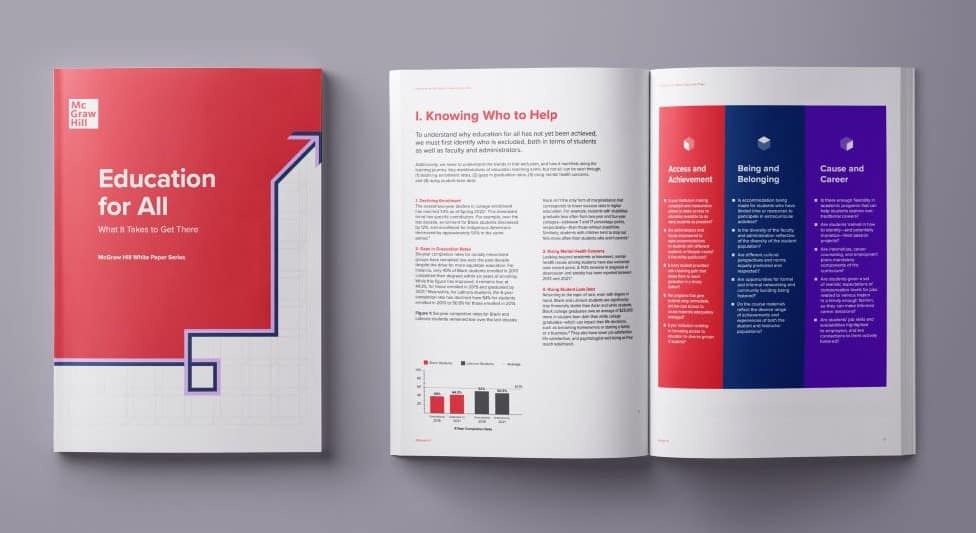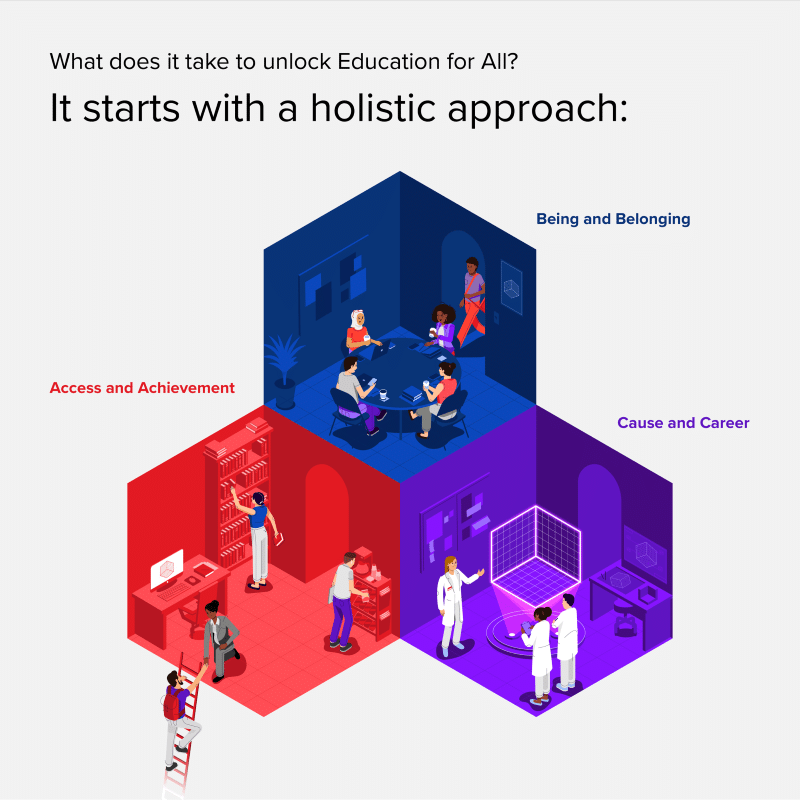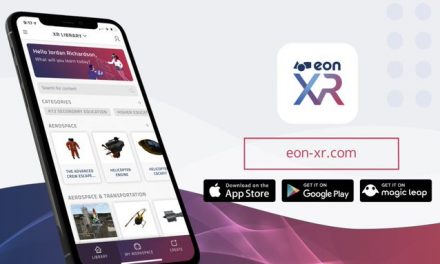January 28, 2023
By Anne Olderog, Cerrone Lundy and Aya Asali from Vivaldi

Shouldn’t education be available to everyone? Why has this goal eluded us for so long?
In the new white paper, ‘Education for All: What It Takes to Get There’ McGraw Hill offers new insight on how institutions can understand individual student needs and provide them with appropriate resources to meet those needs and achieve their academic goals.
There is a critical need – the reality remains, education is still only accessible to some, while others are left behind. Indeed, 98% of institutions acknowledge this problem, 56% of which have looked for solutions. So why, then, have only 2% made any real progress?
In answering this question, McGraw Hill collected new insights on where we currently stand, what can help us overcome persistent challenges, and how institutions can leverage effective practices and technology to shift momentum in the right direction.
The white paper includes evidence from numerous students, administrators, instructors, and academic experts across the country. Let’s break down some of the key findings.
Knowing Who to Help
Key manifestations of education reaching some, but not all, can be seen through declining enrollment rates, gaps in graduation rates, rising mental health concerns, and rising student-loan debt.
College enrollment has been far lower for black students and indigenous Americans in particular. Meanwhile, gaps in Graduation Rates for racially minoritized groups have remained low over the past decade despite the drive for more equitable education. For instance, only 40% of Black students enrolled in 2010 completed their degrees within six years of enrolling.
Looking beyond academic achievement, mental health issues among students have also worsened over recent years. A 110% increase in diagnosis of depression and anxiety has been reported between 2013 and 2021 according to a Journal of Affective Disorders study from 2022.
Finally, as we face up to a tougher economic climate globally, Black and Latino/a students are significantly less financially stable than Asian and white students. Black college graduates owe an average of $25,000 more in student-loan debt than white college graduates—which can impact their important life decisions.
Knowing Where to Focus
McGraw Hill worked with instructors and administrators to develop a new Success in Higher Education Framework to help institutions structure their efforts in a holistic way. This includes three key areas:
1. Access and Achievement
This refers to the student’s ability to be admitted, have the financial support and required materials, and excel academically in higher education.
Students need access to institutions as well as resources that meet their basic needs, so they have space to focus on their academic goals.
Universities and colleges can use techniques such as Inclusive Access (IA) to be able to reduce the barrier to course materials and improve student grades. Maysville Community and Technical College in Kentucky applied IA to its course materials, and according to our prior research, the number of students who earned As, Bs, and Cs rose 21%.
In times of widening preparation gaps, institutions should take steps to meet students where they are at. For example, adaptive learning tools such as McGraw Hill ALEKS® can help – personalized software powered by Al that can determine the student’s baseline of knowledge, then create a tailored and dynamic path forward.
After the first full implementation of ALEKS Math in three sections in Fall 2021, ASU Online experienced an 11% increase in student success for those who received a C or better compared to the previous semester. There is room for more widespread adoption of personalized learning technologies to get students up to speed.

RECOMMENDED: https://global-edtech.com/category/edtech-market/
- Being and Belonging
This focuses on the students’ beliefs that they can be themselves, and are a valued member of the institution’s community.
While academic achievement is certainly a goal in Education for All, it is impossible to reach if a student does not feel they belong or does not have opportunities to participate in their academic community.
Data shows that about half of working students (51%) do not have time to participate in extracurriculars and interact with peers; and more than half of working students who work 15-35 hours per week had a Grade Point Average (GPA) of 2.0 or below.
For example, the University of Florida uses TikTok—the social platform that Gen Z spends 4x more time on than all others—to highlight campus culture and student life to current students. The @UF account has more than 103,000 followers, celebrates alumni and features cameos by university president Kent Fuchs.
- Cause and Career
This recognizes the student’s need to find and pursue their purpose while also being prepared for the real world.
Possession of a degree is no longer an absolute guarantee of getting a job, and just having a career management office available to students is no longer enough. Instead, institutions should be engaging in employer collaboration, according to 70% of respondents in a study of business leaders released by BCG and Google in 2020.
One great example of a tech solution helping in this area is Skill Up. This is a nonprofit coalition that works with higher education institutions to support learners from all backgrounds, connecting graduates to personalized tools, resources, and support. They use a rapid reskilling model, which enables workers to build new skills suited to jobs that are most in demand. Skill Up has connected over 850,000 workers to career and training support.
Meanwhile, Grow with Google is an initiative that helps people get the skills they need to get a job or grow their business. Google Career Certificates are qualifications in high-paying, high-growth job fields that don’t require a college degree; instead, these career programs are designed and taught by Google employees who work in these fields.
In response to these trends there are four key paradigm shifts in mindset that must occur:
1. Listen to Your Students
Institutions that want to be the change can start by really listening to the marginalized and minoritized voices who have been shouting into vacuums for too long.
2. Create Student-Centric Programs
Just as a seed needs air, water, nutrients, and sunlight to grow, learners need a combination of programs working in concert to thrive. By focusing on what we know are the best practices for student success, programs can be designed to address the needs of the whole learner.
3. Leverage Your Community
We understand that higher education institutions have finite funds. But rather than being a limiting factor, it could be an impetus to creativity. Looking to the local community for strategic partnerships can help distribute resources, but also helps connect the entire student and faculty population to other stakeholders in their community.
4. Let Innovation Help
Institutions currently leading the way with successful initiatives are those that aren’t afraid to try new methods. Adaptive technology platforms already allow instructors to track students’ progress and be informed to step in with more help if needed. Other new technologies open more possibilities.
For example, the metaverse can enable multimodal interactions with digital items, virtual environments, and people to enable institutions to cultivate empathy for marginalized people in a safe space for all.
Ultimately, by putting together all three pillars— Access and Achievement, Being and Belonging, and Cause and Career—we can transform the vision of Education for All into reality and reshape the future of higher education.
‘Education for All: What It Takes to Get There’ is a key resource for all educators to understand how they support all learners towards achieving their academic endeavors.













